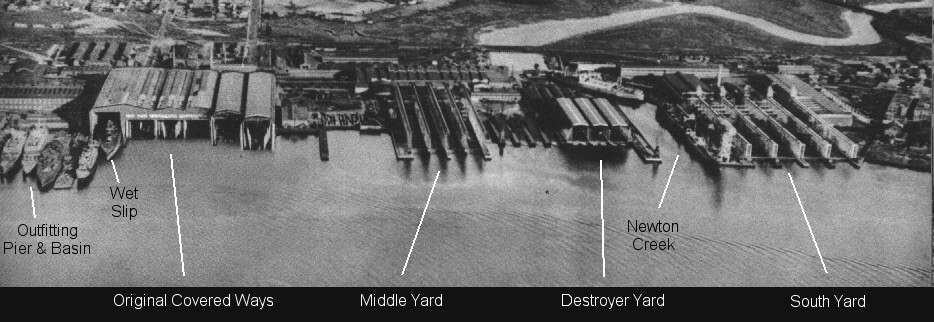
The Facilities
 |
A Place Called YORKSHIP The Facilities |
| Last Revised: 24 May 2009 |
"New York Shipbuilding Corporation's plant is the largest and most comprehensive unit in America's shipbuilding strength. With shipway capacity for twenty-eight vessels at one time, together with ample outfitting basins and complete shop and storage facilities, it ranks with the largest plants in the Old World. At one period during the peak of wartime production, the yard was actively at work on no less than forty-three ships on the ways and in the outfitting basins."
--New York Shipbuilding Corporation: A Records of Ships Built (1921)

"From left to right along the water front, as shown [above], are two of the largest outfitting piers and the main covered unit which consists of a wet slip and five double ways; then the Middle Yard comprising four single ways capable of development into two huge single ways for the construction of ships up to 1,000 feet in length; beyond them the Navy Department's destroyer-building unit with four open and six covered ways; and, lastly, across Newton Creek which has been developed into an outfitting basin, the four large single ways which constitute the South Yard."
--New York Shipbuilding Corporation: A Records of Ships Built (1921)
The original site for the New York Shipbuilding Corporation's Camden facility was a 160-acre farm on the east side of the Delaware River, north of the mouth of Newton Creek. According to an official company history, "The ground conditions were especially suited to the building of shipway foundations, and railway facilities were adequate." Ground was broken on July 3, 1899. The farmhouse was moved closer to Broadway and used as part of the Employment Office and Hospital complex.
First built were three covered shipways (designated J, K, and L) and a covered wet slip (H) used for outfitting. The structure incorporated an enormous mold loft where hull plates were fabricated from templates--a process NYSB pioneered in the shipbuilding industry. Other fabrication shops nearby produced relatively large structural assemblies, including engines and complete turrets, which were handled in the ways by overhead bridge cranes with capacities up to 100 tons. The keel of NYSB's first ship, the oil tanker J.M. Guffey, was laid in shipway L on November 29, 1900, while the shipways themselves were still under construction.
Two additional covered shipways were added in 1912 (M) and 1915 (O). At the time, they were the largest ways in any American shipyard.
Just prior to World War I, the company started constructing four additional open shipways and affiliated shops to the south of the original facilities. This area became known as the Middle Yard, and the original complex became the North Yard.
World War I
Between July 11 and December 29, 1917, the US Navy ordered thirty torpedo boat destroyers from NYSB. The first eight were built in the North Yard while additional ways were built adjacent to Newton Creek on the north. This facility was known as the Destroyer Yard. At its peak of activity, the Destroyer Yard had ten vessels building, six of them on covered ways.
The final phase of World War I expansion was the construction of the South Yard on the south side of Newton Creek, which operated as a self-contained shipyard with its own shops, power plant, and administration building. The South Yard with its four open ways was built in cooperation with the Emergency Fleet Corporation, which had ordered a fleet of sixteen large transports, all over 500 feet in length. These "State" class vessels were completed as first-class passenger liners after the Armistice.
By 1921, there were fifteen miles of standard-gauge rails and five miles of roads within the plant. An array of 115 cranes, with capacities ranging from 1.5 tons to 200 tons, kept raw materials, components, and subassemblies moving through the shops and shipways.
World War II
Unlike during the First World War, between 1941 and 1945 the entire capacity of New York Shipbuilding's plant was devoted to the production of vessels for the U.S. Navy--principally cruisers and aircraft carriers. No major facilities were added during World War II, though the covered shipways and wet slip of the North Yard were extended up to 250 feet to accommodate the building of six 30,000 ton Alaska-class battle cruisers (808.5' long).
The former Destroyer Yard was used for steel storage. The South Yard was hastily converted to a barge plant for the production of 112-foot long LCTs (Landing Craft, Tank), at a rate of up to ten a week. Pier 7's massive hammerhead crane allowed a completed LCT to be "launched" on a hook, and the LCTs were outfitted along the south bank of Newton Creek. New York Ship in 1948
The Cold War
The Cold War brought one final change to the shipyard's waterfront. The Destroyer Yard, which had stood idle since 1920, was swept away and replaced by a 1000-foot long deep-draft drydock needed for the construction of the 60,000-ton aircraft carrier USS Kitty Hawk--destined to be the longest and heaviest vessel which would ever be built in Camden.
![]() your
Yorkship memories to Michael
Kube-McDowell, Class of '68
your
Yorkship memories to Michael
Kube-McDowell, Class of '68